Four Coloured Cards: A Postcard from
Davenport No.8.
A Davenport history feature, written by Charlie Hulme
Davenport Station home | Index to History pages
Edwardian Colour
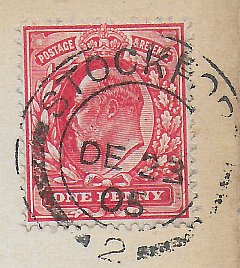
In the early 1900s, when postcards were the equivalent of today's emails, millions were printed, and many of them have survived to the present day to be sold to collectors on eBay or from postcard fairs.
The four cards pictured here, gathered together 1n 2020 for enlargement to display in the Friends Group's little gallery in the station waiting room, were all printed between 1900 and 1910 in the Saxony area of Germany, where a method of colour printing had been perfected.
Picture postcards first appeared in the UK in 1894. A standard size was adopted in 1899, but the Post Office would not allow anything other than a name and address on the plain side, so any message has to be fitted on the image side. The 'divided back' style we know today was finally allowed in UK internal post in 1902, which help with dating, although the original photograph might be older than the postcard based on it. All four of these cards are the divided back version; the top one has writing on the front as postcards to other countries still had to follow the old rule for a few years longer.
Cards no. 1 and 4 were printed in Germany and published by 'The Wrench Series', a company which started life in 1900 and closed in 1906.
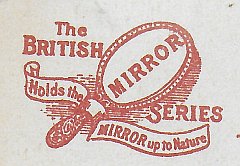
No.2 is from the 'British Mirror' series, also printed in Germany and sold by the Knight Brothers, former employees of Wrench.
No.3, also a German product, was published by Stockport firm 'The Grenville Series' founded by a couple who lived in Grenville Street, Edgeley. Their output, mostly monochrome cards, featured hundreds of scenes from the Stockport area and out into Derbyshire and Cheshire, and are much collected today.
Contributions are very welcome:
info@davenportstation.org.uk
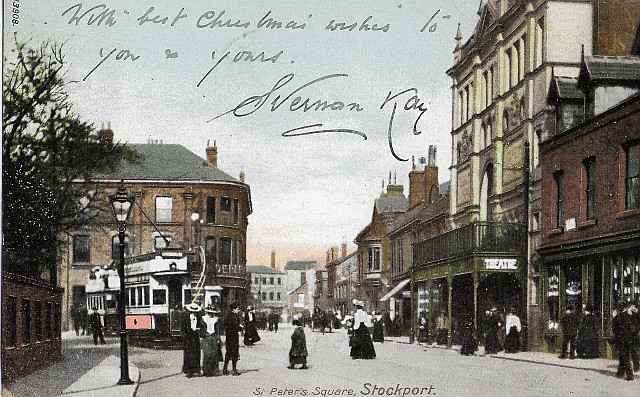
No.1: View of St Peters Square, Stockport. Posted by Samuel Vernon Kay to Albert Kleist, Esq., Brussels, 23 December 1905. Conspicuous on the right of the view is the Theatre Royal and Opera House, built in 1888 to a design by well-known theatre architect Frank Matcham, on the site of an older Theatre Royal which had been destroyed by fire. The theatre closed in 1960 and demolished in 1962, replaced by a building, still standing today, in the basic style of the period for the Abbey National Building Society which at some time included a supermarket if our memory serves. The building on the right was replaced in the 1920s by the curved stone block of Prudential Buildings. The building behind the trams, with Hidderley's wallpaper shop on the corner. was replaced in the 1970s.
Stockport's trams were in a period of change at that time; the one nearest the camera is an electric one, although the colouring artist has removed some of their wires; behind is a horse-powered tram.
Samuel Vernon Kay was the son of Samuel Kay who with his brother Thomas founded Kay Brothers, chemical manufacturers. Samuel and his son lived in Charlestown House, a large villa on the corner of Bramhall and Woodsmoor Lanes. Our article 'The Charlestown Story' has more details.
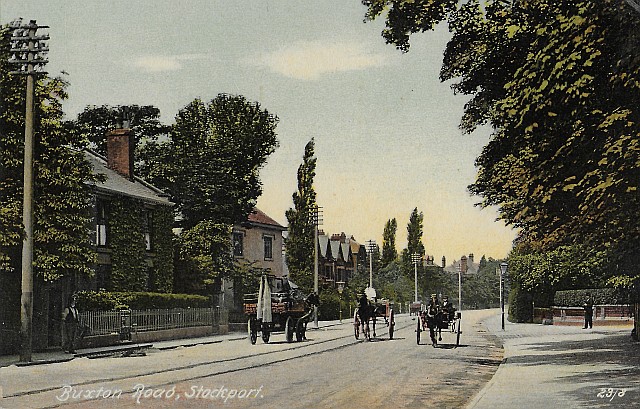
No.2: Buxton Road, Stockport. The scene is the junction of Mile End Lane (right) and Buxton Road, looking north. Note the single line of tramway rails: the Stockport and Hazel Grove Carriage and Tramway Company completed its horse-worked tramway line from Stockport to Hazel Grove in 1890. The line was purchased in 1905 by Stockport Corporation, who converted it to an electrically-worked double-track line in the first half of 1905. The lettering on the cart can be reconstructed as D. Clifton & Co. Ltd, Ale & Stout Bottlers, Stockport. Daniel Clifton's Royal Oak brewery in Cooper Street has recently been converted to apartments; he lived at Mile End Hall, and among his 'tied' pubs was the Jolly Sailor in Davenport. The two old houses on the left have not survived - 'Kwik Fit' now occupies the site - but the gabled houses beyond are still very much in use in 2020.
On the back of the card is written 'Mrs Burtinshaw's house is in the park on the left of this view. We live on the right hand side further down.' This probably refers to Emily Burtinshaw, who lived with her husband James (owner of a Tin Plate works), their children and servants at 'Wythburn', 12 Davenport Park Road.
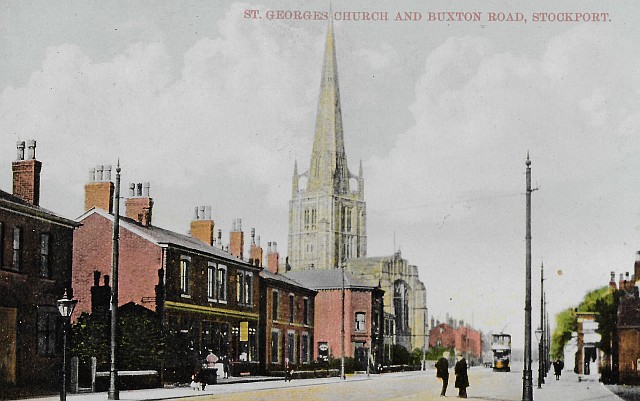
No.3: St George's Church and Buxton Road, nearer Stockport than no.2, looking north. The trams are now electric, and the telegraph wires have been replaced by the poles fir the tramway supply. The church was nearly new, having been completed in 1897. Some of the buildings in the foreground are still there today, including 48 Buxton Road, on the corner of Dundonald Road, which for many years until recently was a supplier of home brewing products, but at the time of the picture was occupied by Alfred Stansfield, Grocer.
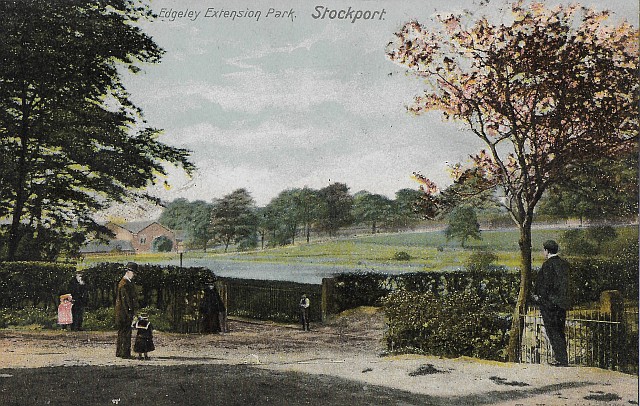
No.4: Edgeley Extension Park. This is taken where Dale Street, which passes between the reservoirs of the Sykes bleach works. Curiously, some of the bystanders, rather than looking at the camera as often seen in such views, seem to be waiting for something to happen. Here the path crossed the railway line which connected the bleach works with the main railway line near Edgeley station. A man, probably a works employee, is standing on the track. The movement of some wagons is, it would seem, about to take place.
The rails were removed sometime around 1960, and the trackbed is now a public path at this point. The works itself closed in 1987. The 'Sykes Meadow' housing estate now occupies its site, while the reservoirs remain as an attractive feature of the park.
Written by Charlie Hulme, January 2020.